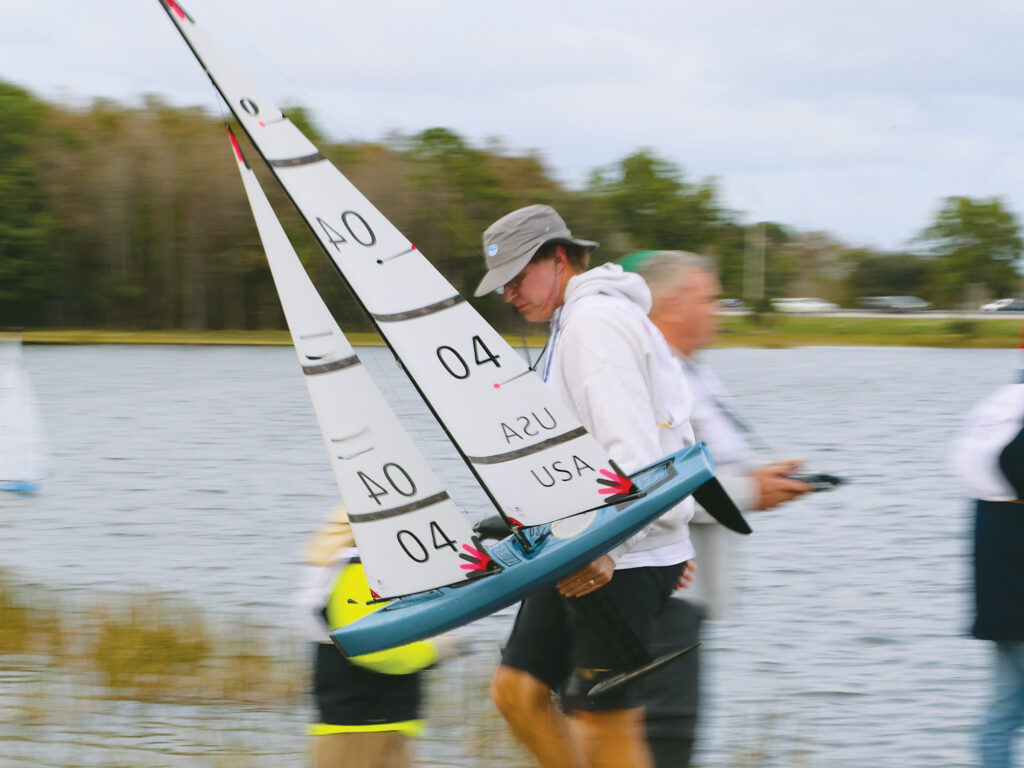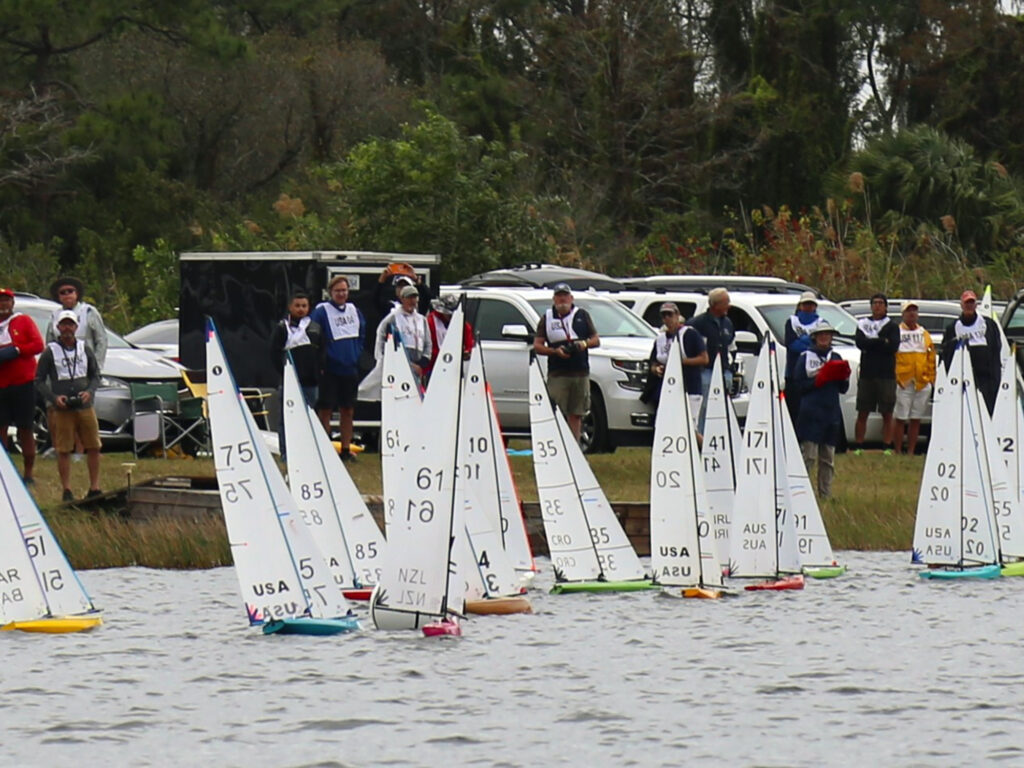
It’s a cool fall day with a brisk sea breeze bending the seagrass on the low-lying peninsula that is the northernmost tip of Rhode Island’s Aquidneck Island. A lonely figure, clad in waders, moseys across the beach, shale fragments and Lady Slipper shells crunching underfoot. He pauses at the water’s edge, tinkers with the sailboat in hand, and then rhythmically waves it through the air, back and forth, watching the boat’s sails with a critical eye. He then steps gingerly across the shallows and treads into deeper water before slipping the 39-inch craft into the bay, watching it heel onto its lines and sail away straight and true.
The waterfront residents here are used to fishermen who pass and cast, the shell collectors, and the dog walkers. But this guy is new, and now he’s a regular. Three times a week or more, he comes alone, launches his remote-controlled sailboat, and guides it back and forth and around mooring balls. After each run, he steers the little yacht back to shore, tinkers again, and repeats the pattern until the sun goes down or nature calls.
The neighborhood gawkers have no idea that this guy who comes and plays with what appears to be a simple toy sailboat is one Ken Read, the decorated yachtsman. And his little yacht is anything but simple. It’s a new International One-Metre and his latest fascination. It’s good for his soul, but it’s even better for his results in real boats.
“I am totally convinced I am looking at the water better, seeing the breeze, working on the importance of boat balance, and tactically thinking ahead,” says Read, president of North Sails and a recent convert to remote-control sailboat racing. “I like what radio sailing is doing for my big-boat sailing.”
Read got his start in the talent-rich local DF95 one-design fleet that his brother Brad started a few years ago, off Sail Newport’s docks, but the elder Read is now neck-deep in the International One-Meter world, the grand prix of model yachting, if you will. Whereas the DF95 is essentially a boat-in-the-box, the IOM is a box-rule class for serious tinkerers.
“The DF 95 has some little tuning tricks, and it’s easy to get into the class,” Read says. “The IOM is a different animal. It’s a lot heavier, mainly in the bulb, and has much more sail area. It’s a bigger boat, which makes it behave more like a real keelboat—it glides through tacks and jibes.”
The winches are faster, he adds, which makes boathandling a bit more challenging.
“There is a lot to play with on the boat, so you have to understand how tuning really works to sail an IOM well,” he says. “I love that aspect of sailing, but you have to be ready for playing in a custom class. For those of us who can’t afford a TP52, which is also a box rule, this is a pretty good option.”
Read, who regularly cleans up in the Newport DF95 fleet, got his first taste of IOM sailing a few years ago. A friend in Connecticut loaned him a BritPop design a few days before a local regatta. He finished fifth, and the hook was set. Afterward, he connected with Zvonko Jelacic, a world champion and IOM boatbuilder from Croatia (the company is called Sailboat RC). “Jelacic reached out and asked if I was interested in trying one of his boats, called a K2, and sailing the 2023 IOM North Americans [hosted at the Hobe Sound Radio Sailing Club’s model-yacht pond in Florida],” Read says. “My only condition was that I could get hold of the boat I was going to sail at least two months earlier so that I could start to learn what I was dealing with. When he ships a new boat, it’s rigged and ready to go, and then the tweaking starts.”
Remote-control sailboats are no different than real boats in that balance is the goal: neutral to no lee helm and the ability to take one’s thumbs off the controls and have the boat sail straight through gusts and lulls.
“The objective is to be higher and faster, and the boat kind of sails itself, so you can spend time looking for the next shift and don’t have to stare at the boat to stay on track,” Read says. “Nothing new here: Good start, first shift, go a little quicker than the competition.”
His IOM tuning matrix details the familiar adjustments that must be preset before sending the boat out to the racecourse unmanned: mainsheet, jib sheet, rake, jib-tack position, mast ram, backstay, shroud tension, spreader length and angle, jib and main cunningham, and outhauls for both the main and jib. The next step is memorizing settings for different conditions—every knot of windspeed and every type of sea state.
“There’s a lot to sort out, which proves the fact that the good sailors doing this for a while are really good at it,” Read says. “Currently there is a whole new method of setup that is trying to make the sails and mast much more dynamic. When a puff hits, there’s nobody on the boat to trim or ease or pull on the backstay, but imagine if that happened on its own? Stand by.”
The IOM Class calls itself the pinnacle of remote-control sailing, so it’s natural for Read, who’s checked boxes at other pinnacles (America’s Cup and Volvo Ocean Race) to be lured into a realm that the class says demands “precision, tactical skill, and technological expertise.” It’s been around since the late 1950s, and as with most development classes, new shapes come and go, but today, there are a handful of go-to designs.
“Rigs, weights, sail area and hulls all have to fit into a box, and from there, it is a free-for-all,” Read says. “But what is remarkable is with all of these differences, how close everyone is in speed. K2s are rumored to be better in a breeze, and Venti may be a bit better in the light. The V12 that Ian Vickers makes is an all-around boat, and the BritPops are just fine.”
With the North Sails design team and their tools at his disposal, it’s not surprising that Read is keen to put some of his own skins in the game. “I am talking with Zvonko about throwing some science at his one-piece molded sails,” he says. “North Sails invented one-piece molded sails, so that seems like a good fit, but we shall see. The sails on all the boats, if set up right, are impressive, so there aren’t huge gains to be made here.”
This past December, Read left his waders at home and packed his shorts for the 75-boat North American Championship. The Hobe Sound boat park, nestled between the roaring Florida Turnpike and Route 95, was littered with RVs, a rainbow of hulls, coolers, toolboxes, and bins of spare parts. “The whole thing was surreal,” Read says. “People take it very seriously.”

He knew a few of the big names, and while most of the thumb yachters knew of him, he was still a newbie among the many masters who embraced him and showed him the way. “Mark Golison and Peter Feldman (world champions in numerous RC classes) were very willing to tune pre-race,” Read says. “I was lucky that they would line up with me.”
Over five days, in abnormally wet and windy conditions, Read battled his way to the top of the fleet and remained there throughout, finishing third overall, but earning the IOM North American champion title because Jelacic and Vickers are internationals. “RC racing has this crazy scoring system where you go up and down flights depending on where you finished. The goal is to make it to A fleet and stay there,” Read says. “I think I was the only person who never got pushed down a level, which I was proud of. As the regatta went along, all of a sudden it was clear that I was in the hunt, which was both shocking and exciting.”
With a new trophy to add to his pile, Read returned home with a newfound enthusiasm for the class, and while staying true to his DF95 brethren of the north, he’s now also recruiting for Newport, Rhode Island’s first IOM fleet. There’s even talk of hosting the 2025 IOM North Americans. “We have a great group of folks here who love remote-control sailing and the camaraderie,” he says. “Bringing others along and helping them tune will only make me better nationally and internationally, so that is always part of the deal.”
While Read’s north-shore neighbors might see more of him in his waders this spring, honing his little boat, he assures his co-workers and bosses that it’s simply a hobby and a healthy obsession that keeps him sharp and connected to the sport for 30 minutes a day. “It would take a lot of IOM sails to make up for one jib for a 100-footer,” he says. “Believe me, I know where my bread is buttered.”









